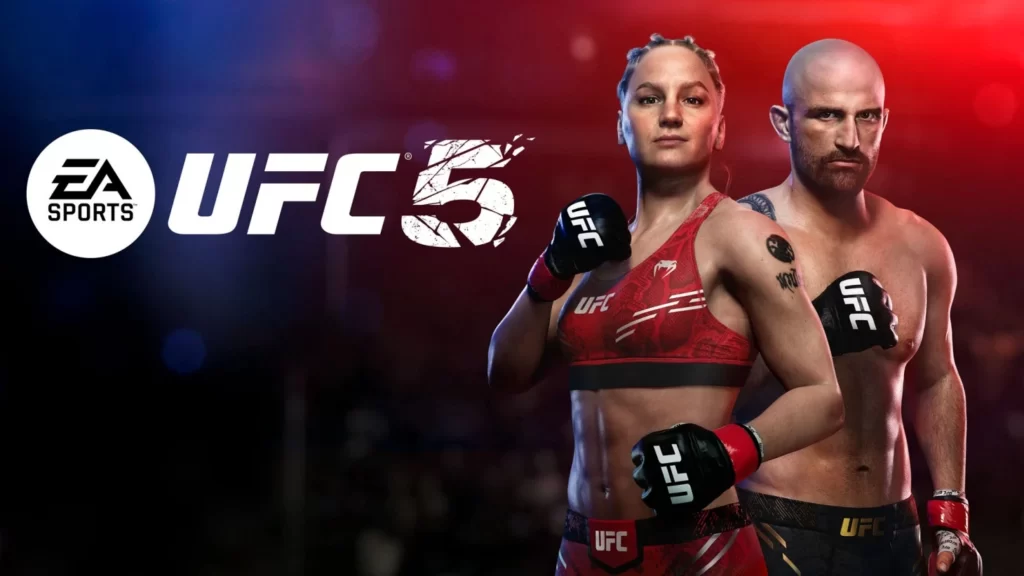EA Sports UFC 5 Review: An In-Depth Look at Gameplay, Graphics, and Features
EA Vancouver’s UFC 5 is uniquely positioned within the sports gaming landscape. Unlike the typical annual release cycle, there’s a significant three-year gap between this title and its predecessor, UFC 4. UFC 4 brought significant improvements in gameplay and the career mode, setting the stage for high expectations surrounding UFC 5.
Upon diving into the game, it’s evident that UFC 5 made the most of this extended development period. The game bids farewell to last-generation consoles and welcomes the Frostbite engine, making its debut in the series. Additionally, UFC 5 proudly bears an M rating due to its realistic portrayal of mid-fight damage inflicted on fighters.
Gameplay:

A major draw for any sports game sequel is how it listens to player feedback and enhances the gaming experience. UFC 5’s gameplay improvements may take time to be obvious, overshadowed by the remarkable realistic damage systems made possible by next-generation consoles.
The game introduces a range of impressive features, such as the ability to target specific body parts to affect a fighter’s speed and power. A leg injury can make a fighter limp, while facial cuts impact vision and defensive abilities. Players can exploit injuries like a shattered nose, which affects a fighter’s stamina due to changes in breathing.
UFC 5 also incorporates rare doctor stoppages, adding to the authenticity of the in-game experience. The fluid action at 60 frames per second enhances striking and defensive capabilities, creating a more responsive and enjoyable gameplay experience.
One standout feature is the seamless submission system, which removes minigames in favor of a straightforward submission gauge that players must manage. Fighter ratings play a more significant role, with noticeable differences in speed and agility based on each fighter’s attributes.
The depth of gameplay systems offers room for skill development, particularly in submissions, where experienced players can execute advanced techniques like keying submissions out of reversals and takedowns.
Graphics and Presentation:
UFC 5 stands out as one of the most visually impressive sports games on the market. Its photorealistic graphics, running smoothly at 60 frames per second, accurately depict the fighters, and the lighting and shadows are top-notch. Crowd reactions and the overall broadcast atmosphere add to the realism, with swooping camera cuts and impressive light work during fighter entrances.
Sweat and blood droplets and detailed damage progression create a brutally honest representation of the sport. New camera angles offer insights into the fighters’ corners, while informative stat overlays provide vital information. Though intense, The Cinematic K.O. replays further enhance the game’s realism.
Career Mode and More:
UFC 4’s career mode was praised for its realistic approach to fighter development, allowing players to control training, schedules, and scouting opponents. UFC 5 retains much of this experience, with players starting as humble novices and working up to big promotions.
Valentina Shevchenko’s involvement in the career mode serves as a great onboarding process for newcomers, introducing them to the game’s fundamentals. The narrative-based mode is a tutorial, making the game accessible to players new to the sport.
Adding sparring challenges and earning grades for future sessions is a quality-of-life feature that helps players progress more quickly. Players can choose between simulation and strike-focused gameplay styles, adding to the game’s depth.
While there are new cinematics and improved training camp A.I., the career mode may feel too familiar to veterans of the series. It needs some of the depth found in similar games, like WWE 2K, with no options for general manager controls over match cards or backstage activities.
However, adding an online career mode for created fighters with skill-based matchmaking and division progression is a significant enhancement. “Fighter Evolution Points” allow for fighter customization and even prestiging fighters, offering replay value.
The game’s online portion is robust, with features like Fight Week content and daily battles against the computer. Weekly challenges promise increasing difficulty, making for an engaging experience.
“Alter Ego” fighters offer alternate models from specific eras, similar to other games’ ultimate team modes. The impact and monetization of these alternate fighters remain to be seen.
In terms of options, UFC 5 excels, providing players with choices like grappling assists and legacy controls.
Conclusion:
UFC 5 benefits significantly from its extended development time, resulting in impressive presentation and gameplay upgrades. However, the career mode, while still enjoyable for new players, may feel lacking for long-time fans. Despite this, UFC 5 offers a definitive experience with its presentation, gameplay enhancements, and planned support, ensuring it will remain a top choice for fans regardless of the time until the next release.
